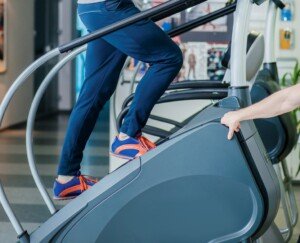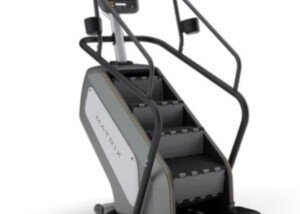
Find out the truth about backwards walking on the stair climber (revolving staircase).
It’s not uncommon to see someone using the stair climber machine backwards.
I’m a huge proponent of keeping one’s hands off the elliptical, treadmill and stair climber (a.k.a. revolving staircase) when using them conventionally.
I also heavily endorse the hands-free approach even when using a treadmill (and elliptical) backwards.
What about going backwards on the stair climber?
My take is to skip this altogether. It is just too loppy to reap any benefits because it forces the feet to be placed on the steps in a totally unnatural manner: front of foot hanging off the step.
Normally, when you climb stairs, the back part of the foot hangs off a little, sometimes more than a little; usually, only the ball of the foot makes contact. Sometimes maybe just about all of the foot makes contact.
In either case, the front of the foot always makes contact. When using the stair climber backwards, the opposite occurs.
The heel strikes first, and the front-most portion of the foot never makes contact (unless you have unbelievably tiny feet).
This alone is the deal breaker for me. Ask yourself just why you want to use the stair climber backwards.
”Ask someone why they’re exercising backwards and they’ll usually tell you they’re trying to tone their butt and the backs of their legs,” says Ben Gelfand, a physical therapist with decades of experience treating a variety of patient populations
Backwards movement on the stair climber recruits less of the gluteal muscles than does stepping forward.
One reason is because the structure of the stepping device eliminates the hip extension necessary for full gluteal use, and so the opposite occurs: minimal hip extension.
What is hip extension? Ever see someone on the stair climber stepping forward, but after each step, the opposite leg is thrust out behind that person in an exaggerated fashion?
That’s hip extension, and that will work the butt. There’s more hamstring use here too.
Backwards stepping on the stair climber is “also not great for the lower back because your posture and body alignment are thrown out of whack,” says Gelfand.
Holding onto the rails causes this problem, yet letting go would be precarious unless you go at level 1, and even then, some people will struggle without holding on. Solution? Skip the backward climbing on the revolving staircase.
 Ben Gelfand is the founder of Professional’s Hip Center of Excellence.
Ben Gelfand is the founder of Professional’s Hip Center of Excellence.
 Lorra Garrick is a former personal trainer certified through the American Council on Exercise. At Bally Total Fitness she trained women and men of all ages for fat loss, muscle building, fitness and improved health.
Lorra Garrick is a former personal trainer certified through the American Council on Exercise. At Bally Total Fitness she trained women and men of all ages for fat loss, muscle building, fitness and improved health.
.


























